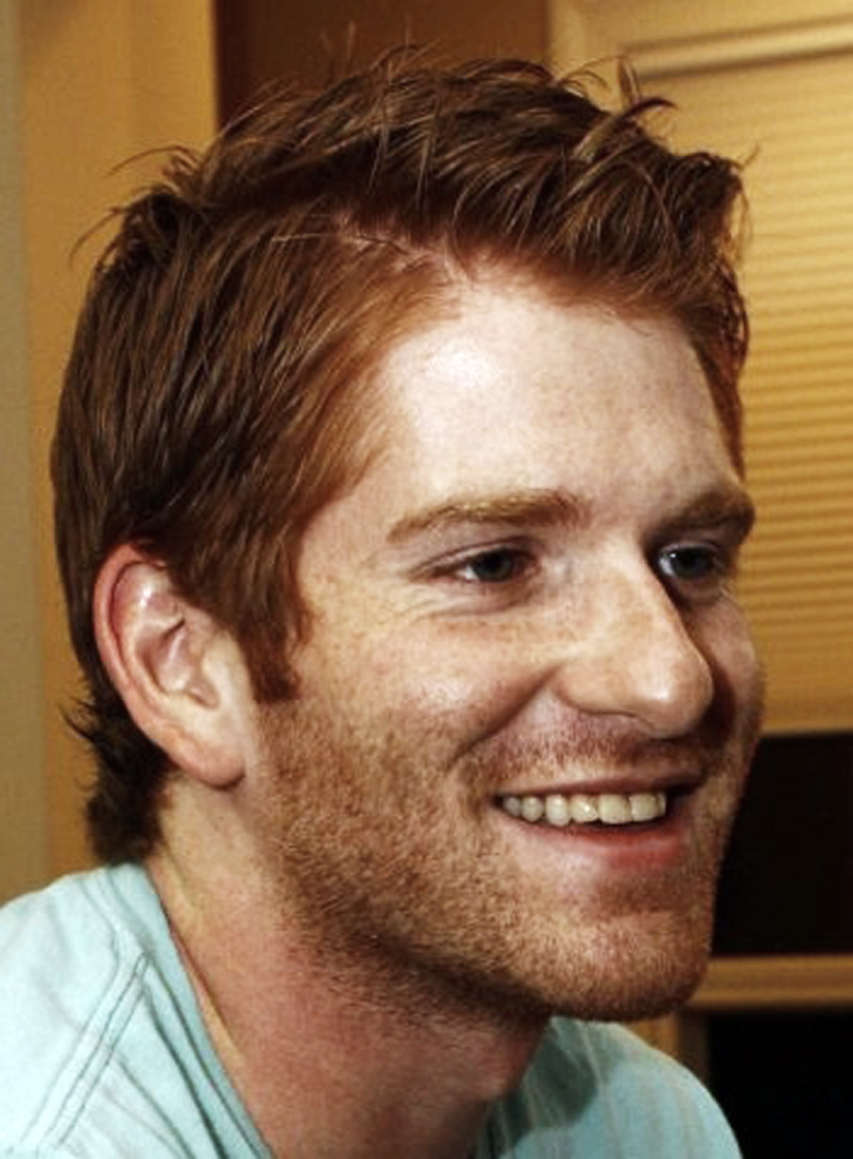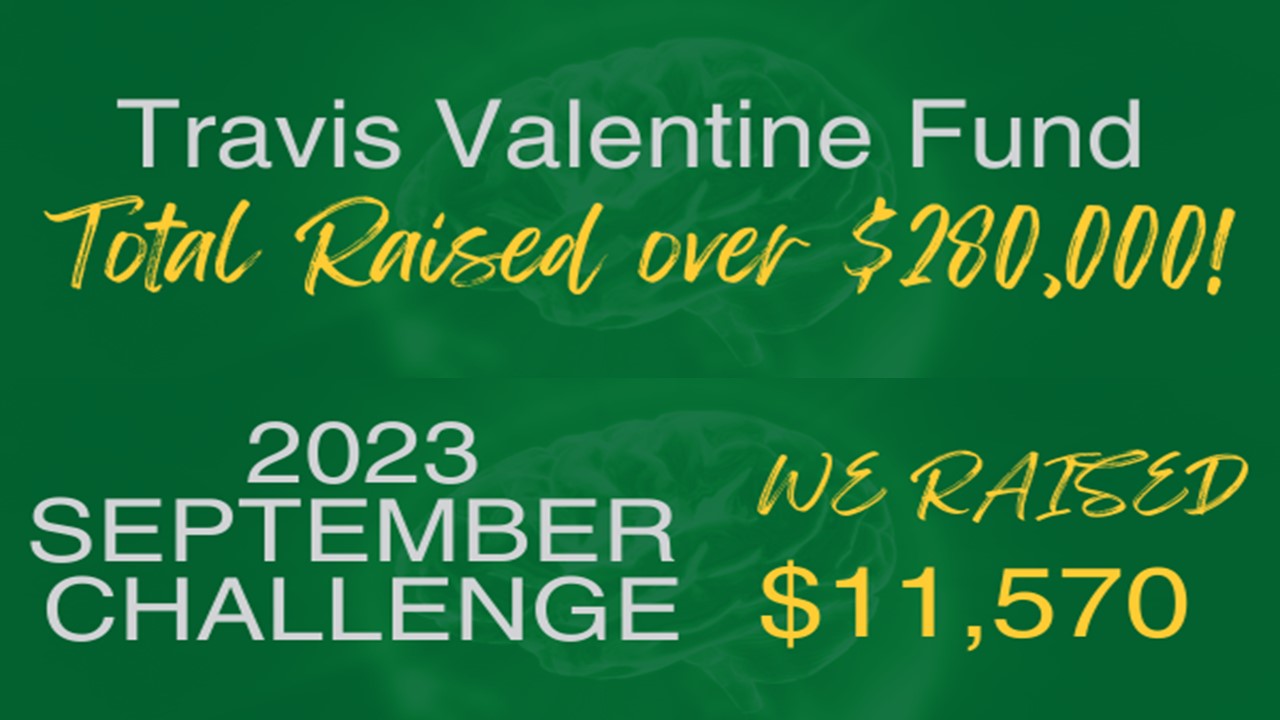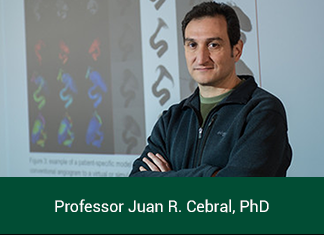The Travis C. Valentine Memorial Aneurysm Research Fund (the Travis Fund) was established in late 2017 to solicit contributions which will support previously unfunded and potentially ground-breaking research projects by George Mason University’s College of Science related to studying brain aneurysms generally, to developing predictive modeling of aneurysm ruptures, and to pursuing a good understanding of aneurysm evolution.

Travis Valentine, cum laude BA Government and International Politics ’05

Join us on 9/30 for our Travis Valentine Giving Day – we hope to reach $5,000 this year on our giving day and $20,000 for the year – we have a long way to go so join us!
Last year we raised $21,670. Thank you to all our 2023 September Challenge donors! Together we raised $11,570.17 for Brain Aneurysm Research at George Mason University!
Since the Travis Fund began in 2017, it has raised over $280,000 for critical Brain Aneurysm Research.
Significant progress has been made in multiple studies sponsored by the Travis Fund! Support for our $20,000 goal in 2024 will continue upon the fund’s success through (IMPACT i.e. Sponsoring Graduate Student Research, Computational Equipment, Costs of Publication of research findings, federal and non-profit research grant applications, etc.)
Donate today to support this important research, as we work together to fund ground-breaking research to help us to understand how we can predict and understand aneurysms – thus saving lives! Click the link below for the most recent annual research report from Dr. Cebral on how our support has made an impact.
View the research updates from the Travis Valentine Fund
Overview
Brain Aneurysms
In layman’s terms, an aneurysm is an area of an artery where its wall weakens—or perhaps has been weak since a person’s birth. This condition allows the artery to balloon out and, for this reason, become susceptible to rupturing at that weak point when enough pressure is applied to it.
Brain or “cerebral” aneurysms are among the primary types in the body. It is estimated that approximately one in 50 people in the United States have an unruptured brain aneurysm. It is also estimated that there is a brain aneurysm rupturing every 18 minutes in the United States. About 40% of such cases are fatal. About two-thirds of the remaining non-fatal 60% of ruptures result in some permanent neurological deficit. Approximately four out of seven people who recover from a ruptured brain aneurysm will have lasting disabilities—physical or mental or perhaps both. Fortunately, aneurysm rupture is rare (less than 1% annual risk for asymptomatic aneurysms), but the risk of treatment complications is not insignificant (approximately 10% combining all possible complications). Thus, despite the devastating consequences of aneurysm rupture, it is not appropriate to treat all patients, and clinicians and patients routinely face a dilemma of whether to treat an individual aneurysm or observe it conservatively. Therefore, more precise and personalized aneurysm evaluation is needed.”
Research regarding aneurysms—and particularly regarding the highly debilitating and fatal ruptures of brain aneurysms—has been a chronically underfunded priority for many years. So, Chi Psis were glad to learn of the work done to date by Professor Juan R. Cebral, PhD, in the Bioengineering and Mechanical Engineering Department. Having the opportunity to support work in an area which needs substantive and creative research and also to support Mason faculty members who are already engaged in such work quickly emerged as a natural fit with the desire by family members and fellow Chi Psis to create a meaningful memorial to Travis’ life.

More importantly, the additional work which Dr. Cebral wants to undertake as funding becomes available meshed quickly with the desire of Chi Psi alumni and of Travis’ family and friends generally. As he said in the fall of 2017: “Our research focuses on the use of patient-specific computational models of cerebral aneurysms, constructed from 3D medical images, to gain knowledge about the conditions that predispose aneurysms for rupture and understand the underlying mechanisms responsible for the degradation and weakening of the wall that ultimately results in aneurysm rupture.”
In response to questions regarding research he would like to undertake and whether a current-expenditure fund would be useful even if a long-term endowment takes many years to develop, his response was strongly affirmative.
Potential contributions will be used to advance two research ventures that are currently unfunded and have a large potential impact both in aneurysm research as well as the clinical practice:
Improving Aneurysm Evaluation through Predictive Rupture Models
- PURPOSE: To personalize aneurysm evaluation by integrating aneurysm-specific hemodynamic and geometric characteristics that predispose aneurysms for rupture into statistical models to predict their rupture potential.
- IMPACT: Improve patient assessment by identifying patients that need immediate treatment while minimizing unnecessary interventions (and associated complications) for patients with low-risk aneurysms.
- APPROACH: We will first compare hemodynamic and geometric characteristics of ruptured and unruptured aneurysms as well as unstable (growing or symptomatic) and stable aneurysms to identify conditions that predispose aneurysms for instability and rupture. Secondly, we will build predictive statistical and machine learning models of aneurysm instability and rupture using aneurysm location, hemodynamic, and geometric characteristics in addition to demographic and patient characteristics. To achieve these goals, we will use a database of approximately 3,000 patient-specific aneurysm models developed at GMU with 3D image data from different hospitals/populations, including Inova Fairfax Hospital, the Mayo Clinic, and Mt. Sinai Medical Center. We will perform cross-validation of the models and assessments of their predictive value.
Understanding Aneurysm Disease and Healing Mechanisms
- PURPOSE: To understand how the hemodynamic environment within the aneurysm induces cellular responses in the aneurysm wall which result in structural changes that lead to weakening and ultimately failure.
- IMPACT: Better understanding the effects of local flow features such as flow impingement and vortex flows is important not only to improve the prognosis of individual aneurysms but also to enable new therapeutic approaches without interventions as well as to improve the efficacy and safety of current endovascular devices.
- APPROACH: We will build computational models of aneurysm evolution (including both ruptured and unruptured aneurysms from our database) and study the changes in the hemodynamic environment at different stages of the evolution. Note that aneurysm evolution is extremely difficult to observe because of the small number of aneurysms considered safe for observation without treatment, also because of the long time required to observe the aneurysm progressing, and because if an aneurysm that is being followed is observed to change (e.g. grow) it is treated immediately. Nevertheless, we have been able to create a database of over 200 aneurysms followed longitudinally in time. In addition, we have identified markers of aneurysm instability such as the development of blebs (secondary outpouchings) or symptoms related to nerve compression. In addition, we will study flow changes induced by endovascular devices used for treating aneurysms and how these changes result in healing responses such as thrombus formation, fibrin accumulation, and endothelialization, which ultimately lead to aneurysm exclusion and reconstruction of the vascular wall of the parent artery.
BUDGET:
The funds will be primarily used to push forward impactful research studies that are currently unfunded, with the expectation that they will not only have an immediate impact but also generate preliminary data for future grants.
Specifically, the funds will be used to:
- Support faculty efforts to devote time to these research project
- Support travel and collaboration with multiple centers and clinics to conduct joint research, as well as conference publication opportunities to disseminate results and promote the use of the new discoveries and knowledge in the clinic
- Cover journal paper publication expenses.
How To Support The Travis Fund
The George Mason University Foundation formally created the Travis Valentine Fund in late December 2017. In February 2018 it received its initial contributions and a bequest designation. Since 2017, the fund has raised over $230,000 but we still need more to continue this critical research.
Past, Current, and Future Contributions:
This fund began in 2017 when the undergraduate Chi Psis at Mason devoted their fall Philanthropy Week to raising funds to support brain aneurysm research, and they were able to contribute $2,000 to a separate research foundation that year in memory of their brother, Travis Valentine.
Once the Travis Fund was established, it allowed others to contribute to Dr. Cebral’s research. In the fund’s initial years, the contributions were used to focus on his work as mentioned above.
During the first two years, the fund earned over $81,000, and in 2020 a goal of $20,000 was set. This goal was exceeded again, and it raised $25,000. In 2021 we set a record, raising $74,000! Our goals keep growing and more research is needed.
Current contributions and future will allow us to enable Dr. Cebral and his colleagues to continue the progress on their work and, with such a significant dollar amount of contributions, also attract attention and support from other institutions which will see that the commitment is real and that the research work is serious. We hope to expand the funding to cover additional research over the next ten years to further our understanding of aneurysms.
Help us honor a Mason alum and provide cutting-edge research that will save lives!
Join us in supporting this important initiative with a contribution by making an online gift. If you prefer to write a check, please make it payable to George Mason University Foundation, Inc. with the memo “Travis Valentine Memorial Fund” and mail it to 4400 University Drive, MS 1A3, Fairfax, VA 22030.
We will keep contributors up to date on the use of funds and hopefully on good results that begin to flow from the research over time.
Bequests
The original goal for the first five years was to provide support for immediate research with current/annual fund contributions (including the work of the Chi Psi undergrads). Our new goal is to expand this in 2020 with the hopes of establishing a longer-term endowment that is more sustainable. We can do this with your help!
Want to help continue this research? Bequests start at $400,000 and while bequests are always subject to revision because of donors’ circumstances, an initial bequest would make a substantial contribution to the creation of an endowment corpus in Travis Valentine’s memory.
We need your help to make this endowment. Support the Travis Fund by setting up a bequest. This can be as a beneficiary of an insurance policy, of an IRA or other retirement plan, of an amount from your estate or in another way.
Please contact the College of Science Development team if you are interested at cosalum@gmu.edu. We would be happy to discuss this with you and go over the process.
Please note – this must happen after you have formalized your estate plan with the necessary documents so that your executor/trustee has been appropriately directed to take the action you intend.
For more information on this fund or ways to support it, contact the College of Science Development team
at cosalum@gmu.edu.

